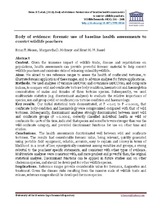| dc.description.abstract | CONTEXT. Given the immense impact of wildlife trade, disease and repatriations on populations, health assessments can"
"provide powerful forensic material to help convict wildlife poachers and minimise risks of releasing unhealthy wildlife."
AIMS. We aimed to use reference ranges to assess the health of confiscated tortoises, to illustrate forensic application of these ranges, and to advance analyses for future applications."
METHODS. We used analyses of variance (ANOVA) and covariance (ANCOVA), and composite indices, to compare wild and confiscate tortoise body condition, haematocrit and haemoglobin concentration of males and females of three tortoise species. Subsequently, we used multivariate statistics (e.g. discriminant analyses) to evaluate the relative importance of species, sex and group (wild or confiscate) on tortoise condition and haematology."
KEY RESULTS. Our initial statistical tests demonstrated, at P < 0.05 to P < 0.0005, that confiscate body condition and haematology were compromised compared with that of wild tortoises. Subsequently, discriminant analyses strongly discriminated between most wild and confiscate groups (P < 0.0001), correctly classified individual health as wild or confiscate 80–90% of the time, indicated that species and sex effects were stronger than was the wild-confiscate category, and provided discriminant functions for use on other taxa and studies."
CONCLUSIONS. The health assessments discriminated well between wild and confiscate tortoises. The results had considerable forensic value, being relevant, quickly generated using portable field equipment, reliable, accurate, easy to explain and convey in terms of likelihood in a court of law, synergistically consistent among variables and groups, a strong rebuttal to the poachers’ specific statements, and consistent with other types of evidence. Multivariate analyses were consistent with, and more prudent and powerful than, the original statistical analyses. Discriminant functions can be applied in future studies and on other chelonian species, and should be developed for other wildlife species."
IMPLICATIONS. Reference ranges provide considerable value for forensics, diagnostics and treatment. Given the disease risks resulting from the massive scale of wildlife trade and release, reference ranges should be developed for more species." | en_US |

